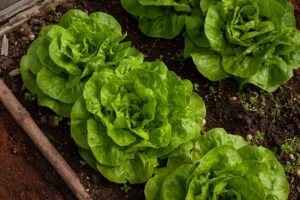Learn how to grow lettuce. Grow your own crisp, fresh lettuce at home! Start from seeds indoors or direct sow outside, in enriched soil. Water regularly, watch for pests, and in just a few weeks, you’ll be harvesting your own healthy greens. It’s easy, rewarding, and delicious!
Choosing the Right Variety
Choosing the right variety of lettuce to grow in your garden can significantly impact the success of your harvest. There are four main types of lettuce: crisphead, butterhead, looseleaf, and romaine. Each variety has different taste profiles, growth habits, and nutritional content, so your choice will depend on your personal preference and local growing conditions.
Crisphead lettuce, also known as iceberg, is the most common type found in supermarkets. It’s known for its large, tight heads and crunchy texture.
Butterhead lettuce forms loose heads and has a soft, buttery texture, hence the name. Examples of this variety are ‘Buttercrunch’ and ‘Boston.’
Looseleaf lettuce doesn’t form a head, and you can pick leaves as needed. ‘Oakleaf’ and ‘Salad Bowl’ are popular looseleaf types.
Romaine lettuce, also known as cos, forms long, upright heads. It’s known for its crisp texture and nutritional value. ‘Parris Island Cos’ is a widely grown romaine variety.
Remember to consider your local climate and the time of year when selecting a variety. Some cultivars are more heat-tolerant, while others perform better in cooler conditions.
Selecting the Planting Site
Selecting the Planting Site
The success of your lettuce crop is heavily influenced by the location you choose to plant. Lettuce is a cool-season crop and prefers locations with full sun in the spring and fall, while appreciating some shade during the hot summer months. Some gardeners plant lettuce near taller crops like tomatoes or beans, which can provide natural shade as they grow.
Finally, consider the accessibility of the planting site. Lettuce requires regular watering, particularly in dry conditions, so proximity to a water source will be beneficial. Also, since lettuce can be harvest-ready in as little as 30 days (for leaf varieties), easy access for frequent harvesting is a plus.
Prepping the Soil
Preparing the soil appropriately is crucial to the successful growth of lettuce. As a leafy green, lettuce thrives in well-drained, fertile soil that is rich in organic matter. Begin by removing any debris, such as stones or sticks, from the planting area. Then, till the soil to a depth of at least 8 inches to ensure it is loose and aerated, promoting root growth and water absorption.
The next step is to enrich the soil. Adding compost or well-rotted manure will boost the organic content, providing your lettuce plants with necessary nutrients and improving the soil structure. Aim for a mix that is roughly one part compost or manure to two parts soil.
Lettuce prefers a slightly acidic to neutral pH, so aim to maintain a soil pH between 6.0 and 7.0. You can test your soil’s pH using a soil test kit from a garden center. If your soil is too acidic (a pH less than 6.0), you can add lime to increase the pH. If it’s too alkaline (a pH over 7.0), you can add sulphur or compost to lower the pH.
Finally, lettuce likes its soil to be consistently moist but not waterlogged. Ensure the planting site has good drainage to prevent water from pooling, which can lead to root rot. Consider adding organic mulch around the plants after they are established, as this will help retain soil moisture and suppress weeds. Remember, taking the time to prep your soil will set the stage for a successful lettuce crop.
Planting the Seeds
When it comes to planting lettuce seeds, timing is key. For most varieties, the optimal planting time is in the early spring or late summer, when temperatures are relatively cool. Lettuce seeds struggle to germinate in temperatures above 80°F (27°C), so avoid planting during the hottest part of the summer.
Start by scattering the seeds directly on the surface of the prepared soil. If you’re planting a larger area, consider mixing the tiny seeds with sand to help distribute them more evenly. There’s no need to bury lettuce seeds as they need light to germinate. Instead, lightly press them into the soil to ensure good soil contact.
Spacing is also important for the growth and development of your lettuce plants. If you’re planting leaf lettuce, aim for a spacing of 4 inches apart in rows that are 12 inches apart. For heading varieties, increase the spacing to 8 inches apart in rows that are 16 inches apart.
Once the seeds are sown, water the area gently with a fine spray to avoid disturbing the seeds. Going forward, aim to keep the top inch of soil consistently moist until the seeds germinate, which typically occurs within 7 to 14 days.
Take note of the first frost date in your area if you’re planting in late summer. Most lettuce varieties mature within 45 to 60 days, so time your planting accordingly to ensure the crop matures before the first frost hits.
Remember, planting the right way is crucial for lettuce growth, and following these steps should help ensure a successful crop.
Caring for the Growing Lettuce
Caring for growing lettuce involves a few key steps to ensure a healthy, robust crop:
Watering
Lettuce has shallow roots, so it will need regular watering, especially in dry conditions. Aim to keep the soil consistently moist, but not waterlogged. Overwatering can lead to root rot and other diseases.
Fertilization
While lettuce isn’t particularly heavy-feeding, a balanced, slow-release fertilizer applied at planting can benefit the growth.
Weed Control
Keeping the garden bed weed-free is essential as weeds can compete with lettuce for nutrients and water. Hand weeding or using a hoe can be effective for larger gardens.
Pest Management
Common pests that target lettuce include slugs, aphids, and rabbits. Slugs can be deterred using natural remedies like crushed eggshells around the lettuce, which also add beneficial calcium to the soil. Neem oil or insecticidal soaps can help control aphids, while fencing can keep rabbits at bay.
Disease Management
Let’s talk about diseases. Lettuce can be susceptible to various diseases, including downy mildew and rot. Proper watering, good air circulation, and crop rotation can help prevent these issues. If diseases do appear, treating with an appropriate fungicide or other disease-specific treatment is often the best course of action.
Remember that preventative measures are always better than trying to cure a problem after it has occurred. By following these steps, you can ensure your lettuce plants thrive and produce a successful harvest.
Harvesting the Lettuce
Harvesting lettuce properly is crucial for the longevity of your crop and to ensure you receive the freshest, crispest leaves. You’ll know your lettuce is ready to be harvested when the leaves are full and firm to the touch. For leaf lettuces, you can cut the leaves once they’ve grown to about 4-6 inches in length. Be sure to leave about an inch of growth above the soil, as this allows the plant to regrow for successive harvests.
When harvesting, it’s best to do so in the morning, as the leaves are most hydrated at this time, which will provide you with the crispest lettuce. Use clean, sharp scissors or a knife and cut the leaves at the base, being careful not to damage the plant’s crown.
To keep your harvested lettuce fresh, rinse the leaves in cool water immediately after harvesting and gently pat them dry. Storing lettuce properly is essential to maintain its freshness. It’s recommended to store the dried lettuce leaves in a plastic bag or airtight container with a paper towel to absorb any excess moisture. Place this in your refrigerator’s crisper drawer, where it can stay fresh for up to 10 days. Remember to check the lettuce periodically and remove any wilted or browned leaves to prevent them from affecting the remaining lettuce. By following these steps, you can enjoy fresh, crisp lettuce from your garden for a good length of time.


